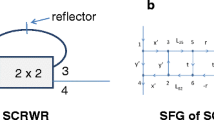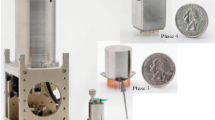Abstract
A simple reticle with parallel equally spaced lines to transmit light in an autometric gyro is shown to give a signal which can be used for very accurate angular precession measurements. Frequency analysis of the signal is chosen over time domain analysis and/or over a specially designed reticle.
Gyro precession will induce a change in the interference structure of the spectrum in addition to dilating the overall frequency distribution. The expected output spectrum has been analytically determined, exhibiting the dependence on spot and reticle line cross sections and line spacing so that they can be precisely determined from the output data.
The spectrum structure is extremely sensitive to precession. Computer simulations indicate that accuracy will be limited by reticle line spacing variations to ±4×10−9 rad. This would allow a Lense-Thirring precession measurement accurate to ±20% in 30 days (accuracy being limited by physical effects common to all such experiments) or a ±1% de Sitter precession measurement in four days.
Similar content being viewed by others
Abbreviations
- a n(ϱ):
-
Fourier coefficients ofI(θ)
- a rn (ϱ):
-
rapidly varying part ofa n(ϱ)
- a xm ,b xm :
-
Fourier coefficients ofI(x)
- a ψ(ϱ),b ψ(ϱ):
-
Fourier sine and cosine transforms ofψ x(x)
- α:
-
angle between star and gyro spin axis
- α0 :
-
initial alignment angle
- f :
-
focal length of optical system
- I :
-
transmitted light intensity, signal function
- l :
-
reticle line width
- r :
-
distance from light spot center
- R :
-
light-circle radius
- ϱ=\(\frac{{2\pi R}}{{l + s}}\) :
-
reduced light-circle radius
- ϱ 0 :
-
reduced reticle center-spin center offset
- s :
-
reticle line space
- T(x) :
-
reticle transmission function
- θ:
-
angle of gyro rotation
- w g :
-
gyro angular velocity
References
Fairbank, W. and Everitt, C.: 1967, ‘Application of Low Temperature Techniques to a Satellite Test of General Relativity’, unpublished report, Dept. of Physics, Stanford University.
Frisch, D. H. and Kasper, J. F., Jr.: 1969,J. Appl. Phys. Vol. 40,8, 3376.
Harrison, G.: 1969, personal communication.
Kasper, J. F., Jr.: 1968, ‘A Feasibility Study of an Orbital General Relativity Experiment’, unpublished Sc. D. Thesis, Dept. of Aeronautics and Astronautics, Massachusetts Institute of Technology.
Knoebel, H. W. and Compton, W. D.: 1966, ‘Research Related to an Experimental Test of General Relativity’, Coordinated Science Lab., University of Illinois.
Lange, B.: 1963, inProceedings 1963 Conference on Unconventional Inertial Sensors, L. I. Farmingdale, New York.
Palamara, R.: 1966,AIAA J. 4, 1036.
Schnopper, H. W., Thompson, R. I., and Watt, S.: 1968,Space Sci. Rev. 8, 534.
Shalloway, D. I.: 1969, ‘Read-out Analysis for an Autometric Gyro’, unpublished S. B. Thesis, Dept. of Physics, Massachusetts Institute of Technology.
Stroke, G. W.: 1963, inProgress in Optics, Vol. II (ed. by E. Wolf), John Wiley and Sons, New York.
Author information
Authors and Affiliations
Additional information
This work was supported by the M.I.T. Center for Space Research under NASA Grant NGL-22-009-019.
Rights and permissions
About this article
Cite this article
Shalloway, D.I., Frisch, D.H. High accuracy precession measurement with an autometric gyro. Astrophys Space Sci 10, 106–121 (1971). https://doi.org/10.1007/BF00654610
Received:
Issue Date:
DOI: https://doi.org/10.1007/BF00654610




